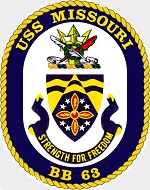Forces of Valor FOV861131B US Navy Iowa Class Battleship - USS Missouri (BB-63), Measure 32, Design 22D Camouflage, Pacific Theatre of Operations, 1944 [Full Hull Version] (1:700 Scale)
"It is my earnest hope, and indeed the hope of all mankind, that from this solemn occasion a better world shall emerge out of the blood and carnage of the past -- a world dedicated to the dignity of man and the fulfillment of his most cherished wish for freedom, tolerance and justice."
- Gen. Douglas MacArthur, aboard the USS Missouri at the conclusion to the signing of the Instrument of Surrender, September 2nd, 1945
 USS Missouri (BB-63) ("Mighty Mo" or "Big Mo") is a United States Navy Iowa-class battleship, and was the fourth ship of the U.S. Navy to be named in honor of the U.S. state of Missouri. Missouri was the last battleship built by the United States, and was the site of the surrender of the Empire of Japan which ended World War II.
USS Missouri (BB-63) ("Mighty Mo" or "Big Mo") is a United States Navy Iowa-class battleship, and was the fourth ship of the U.S. Navy to be named in honor of the U.S. state of Missouri. Missouri was the last battleship built by the United States, and was the site of the surrender of the Empire of Japan which ended World War II.
Missouri was ordered in 1940 and commissioned in June 1944. In the Pacific Theater of World War II she fought in the battles of Iwo Jima and Okinawa and shelled the Japanese home islands, and she fought in the Korean War from 1950 to 1953. She was decommissioned in 1955 into the United States Navy reserve fleets (the "Mothball Fleet"), but reactivated and modernized in 1984 as part of the 600-ship Navy plan, and provided fire support during Operation Desert Storm in January/February 1991.
Missouri received a total of 11 battle stars for service in World War II, Korea, and the Persian Gulf, and was finally decommissioned on March 31st, 1992, but remained on the Naval Vessel Register until her name was struck in January 1995. In 1998, she was donated to the USS Missouri Memorial Association and became a museum ship at Pearl Harbor, Hawaii.
Pictured here is a 1:700 scale replica of the US Navy Iowa class battleship, USS Missouri (BB-63) during 1944.
Sold Out!
Diorama Dimensions:
Length: 15-inches
Release Date: July 2023
 Historical Account: "Measured Response" - In 1935, the United States Navy Naval Research Laboratory began studies and tests on low visibility ship camouflage. Research continued through World War II to (1) reduce visibility by painting vertical surfaces to harmonize with the horizon and horizontal surfaces to blend with the sea, or (2) confuse identity and course by painting obtrusive patterns on vertical surfaces. Some camouflage methods served both purposes. American captains were permitted less freedom of interpretation with these schemes (other than Measure 12 Modified) than their British Commonwealth counterparts applied to Admiralty camouflage schemes.
Historical Account: "Measured Response" - In 1935, the United States Navy Naval Research Laboratory began studies and tests on low visibility ship camouflage. Research continued through World War II to (1) reduce visibility by painting vertical surfaces to harmonize with the horizon and horizontal surfaces to blend with the sea, or (2) confuse identity and course by painting obtrusive patterns on vertical surfaces. Some camouflage methods served both purposes. American captains were permitted less freedom of interpretation with these schemes (other than Measure 12 Modified) than their British Commonwealth counterparts applied to Admiralty camouflage schemes.
With the likelihood of the United States entering the war, and after experiments with various paint schemes conducted in association with the 1940 Fleet Problem (exercise), the Bureau of Ships (BuShips) directed in January 1941 that the peacetime color of overall #5 Standard Navy Gray, a light gloss shade with a linseed oil base, be replaced with matte Dark Gray, #5-D, a new paint formulation with a synthetic alkyd resin base. Rather than waste the large quantities of Standard Gray already in inventory and aboard ships, BuShips directed the issuance of a black tinting paste (5-BP) which when mixed in stated proportions with Standard Gray would yield a close approximation of 5-D, with issue of the new paint in pre-mixed form to follow. BuShips also issued Ship Camouflage Instructions (SHIPS-2), laying out 9 painting schemes to be used throughout the Navy. Rather than issue premixed quantities of the less-used new shades, Light Gray (5-L) and Ocean Gray (5-O), yards and supply depots were directed to issue an untinted base paint (5-U) together with a blue-black tinting material (5-TM) which when mixed according to instructions would turn 5-U into either Light or Ocean Gray


